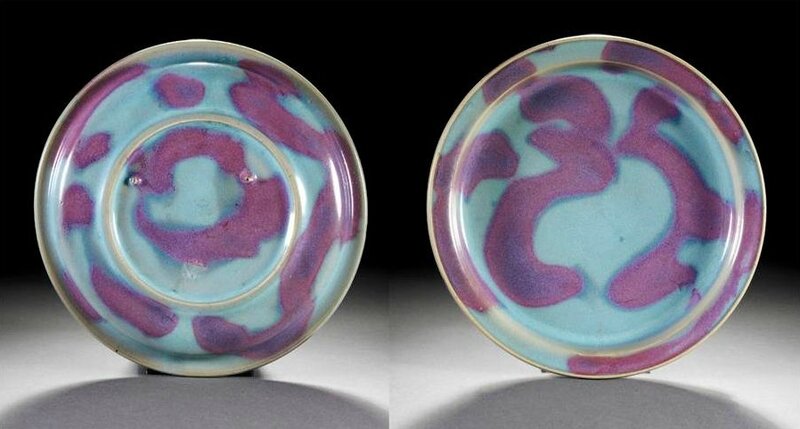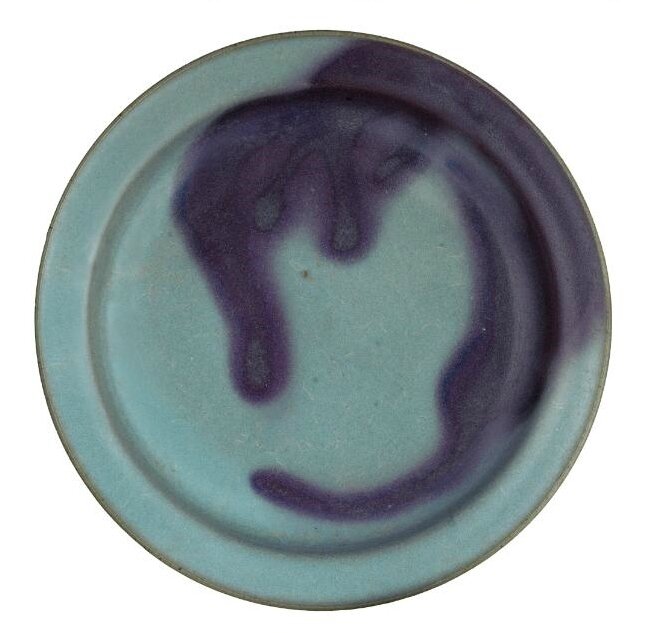A superb Junyao purple-splashed blue-glazed dish, Song-Jin dynasty
Lot 6. A superb Junyao purple-splashed blue-glazed dish, Song-Jin dynasty, 18.7 cm, 7 3/8 in. Estimate 4,000,000 — 6,000,000 HKD. Lot sold 5,140,000 HKD. Photo: Sotheby's.
sturdily potted with shallow rounded sides rising from a short tapering foot to an everted rim, covered overall with a milky sky-blue glaze thinning to a mushroom colour at the rim, the interior and underside liberally decorated with large and vibrant purple splashes, the base with five spur marks.
Provenance: Collection of the Chang Foundation, Taipei.
Literature: James Spencer (comp.), Selected Chinese Ceramics from Han to Qing Dynasties, Chang Foundation, Taipei, 1990, cat. no. 52.
Note: This dish is a masterpiece of abstract art. Since the Northern Qi (550-577) and throughout the Tang (618-907) and Song (960-1279) dynasties Chinese potters in many different manufactories created wares decorated with irregular splashes in contrasting glaze colours. The copper-red streaks on blue Jun wares, however, are different from the rest: they are not fortuitous drips and splashes, but colour patterns that were applied with deliberation. Rose Kerr in Song Dynasty Ceramics, London, 2004, p. 34, notes that the splashes found on Jun wares were made with the application of copper in broad brush strokes or washes over dry bluish glazes, which then merged when fired at full heat. Like an abstract painting, the success of the overall effect therefore depends on the motion of the brush that dictates the distribution across the surface, and on the relative ‘weight’ of one colour in relation to the other. This challenge has been superbly managed on the present dish.
‘Jun’ ware, the most spectacular of the major Song dynasty wares, with its type site represented by the Juntai kilns in Yuzhou, Henan province, was produced by many different manufactories in Henan, including the Ru kilns at Qingliangsi in Baofeng, probably from the end of the Northern Song period (960-1127) until at least the Ming dynasty (1368-1644). The bold, irregular red streaks on Jun ware, as seen on the present piece, had an immense appeal to the literati and nobility of the time due to their simple yet flamboyant, calligraphic effect, which gives each vessel decorated in this manner its unique design.
The outstanding quality of this dish is further evidenced in the five small dot-shaped spur marks on the base. While many Jun bowls and dishes were fired on their unglazed foot rings, the present dish belongs to a small group of wares that were supported in the kiln on three or five spurs, which enabled the overall dish, including the foot ring, to be glazed, a firing method probably copied from the Ru kilns that were located nearby.
Dish, stoneware with blue glaze and coper-red splashes, Jun ware, China, Northern Song-Jin dynasty, 12th-13th century. Diameter: 18.8 cm. Purchased with the assistance of The Art Fund, the Vallentin Bequest, Sir Percival David and the Universities China Committee, C.845-1936 © Victoria and Albert Museum, London 2017.
An exceptional 'Jun' purple-splashed dish, Song-Jin dynasty, Diameter 19cm., 7 1/2 in. Sold for 252,000 GBP at Sotheby's London, 9th June 2004, lot 172. Photo: Sotheby's
of shallow circular form with flanged everted rim, covered all over in a very fine lavender-blue glaze dynamically splashed on both sides in rich copper splashes of purple varying from a pink tint to a deep plum and edged by a rich azurite-blue, the interior with two 'S'-shaped splashes with tips, reminiscent of calligraphy, surrounded by further splashes at the rim, the underside with additional rich splashes, the base with three spur marks.
Note: This 'Jun' dish is remarkable for its rich and attractively distributed purple splashes, reminiscent of Chinese calligraphy. Most comparable dishes are predominantly glazed in blue, but a somewhat similar dish was sold in these rooms, 12th November 2003, lot 134, and two 'Jun' dishes with bright purple splashes from the William Cleverly Alexander collection were sold in these rooms 6th May 1931, lots 144 and 150, the former sold again in our Hong Kong rooms, 21st May 1985, lot 70, the latter now in the Percival David Foundation, illustrated in The World's Great Collections: Oriental Ceramics, vol.6, Tokyo, 1982, col.pl.17.
A purple-splashed 'Jun' dish, Song-Yuan dynasty, from the collections of Oscar Bjork and Klas Fahraeus, 18cm., 7in. Sold for 505,250 GBP at Sotheby's London, 16th May 2012, lot 85. Photo: Sotheby's.
sturdily potted with an everted rim, covered overall with a fine lavender-blue glaze thinning to a mushroom colour at the rim, the interior splashed with purple varying from blue to a deep plum, the base with five spur marks
Provenance: Collection of Oscar Bjork, Sweden (by repute).
Collection of Klas Fahraeus, Sweden.
Sotheby's. Song – Important Chinese Ceramics from the Le Cong Tang Collection, Hong Kong, 03 oct. 2017, 10:20 AM

/https%3A%2F%2Fprofilepics.canalblog.com%2Fprofilepics%2F1%2F0%2F100183.jpg)
/https%3A%2F%2Fstorage.canalblog.com%2F03%2F02%2F119589%2F96711876_o.jpg)
/https%3A%2F%2Fstorage.canalblog.com%2F11%2F31%2F119589%2F94773502_o.jpg)
/https%3A%2F%2Fstorage.canalblog.com%2F20%2F83%2F119589%2F94772815_o.jpg)
/https%3A%2F%2Fstorage.canalblog.com%2F26%2F72%2F119589%2F75604929_o.jpg)
/https%3A%2F%2Fstorage.canalblog.com%2F59%2F60%2F119589%2F26458628_o.jpg)









/http%3A%2F%2Fstorage.canalblog.com%2F96%2F46%2F119589%2F129832814_o.jpg)
/http%3A%2F%2Fstorage.canalblog.com%2F58%2F18%2F119589%2F126160429_o.jpg)
/http%3A%2F%2Fstorage.canalblog.com%2F43%2F90%2F119589%2F126160193_o.jpg)
/http%3A%2F%2Fstorage.canalblog.com%2F69%2F84%2F119589%2F122476404_o.jpg)